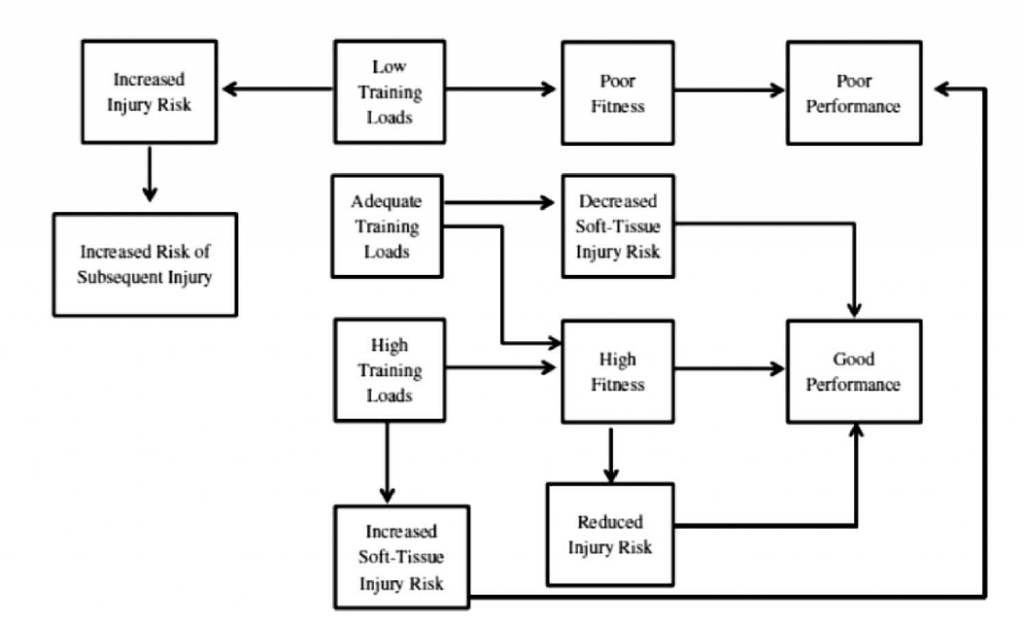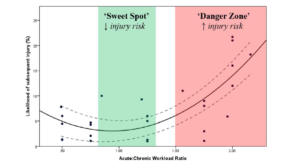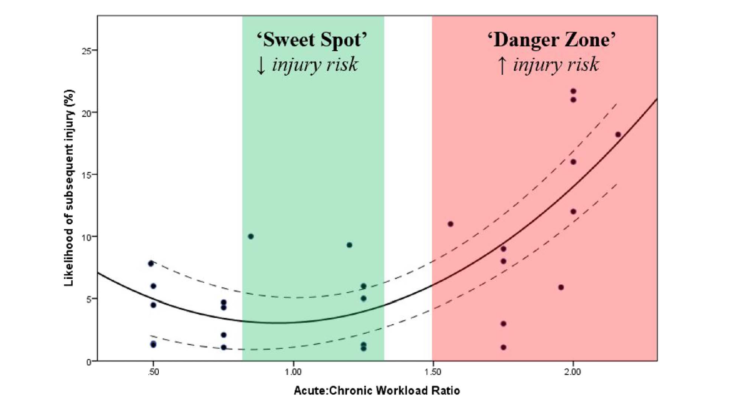Sport Sciences researches have developed during the last decades. Thus, a pool of scientific evidence is available, but prescribing a workload for an athlete is still a challenging task.
Recently, International Olympic Committee (IOC) invited researchers and professional exponents to review the scientific evidence and try to reach a consensus regarding training workload limits.
Based on published papers, it is possible to affirm that risk of injuries is correlated to high workload. However, when submitted to a low workload, athletes might also present a high risk of injury due under preparation for the competition´s demand.
Furthermore, it´s well know that a high intensity training has a protective role and helps to prevent injury, as showed by recent researches. The figure below schemes the relationship between physical abilities, training workload and injury risk in team sports.

Emerging studies affirm that a bad workload management (training sessions and competition) might increase the risk of tissue injuries (bones, tendons, ligaments, muscle) and compromise decision-making actions, coordination and neuromuscular control.
Thereby, the biggest challenge faced by Sport Science is purpose a training workload able to improve athletes´ fitness and performance. Also, avoid spikes that can increase the risk of injuries.
It is well established that athlete´s performance corresponds to fitness minus fatigue:
Performance = Fitness – Fatigue
Therefore, to ensure that athletes are ready to present their best physical performance, a good workload management is required. Recently, an interesting tool was presented by Tim Gabbett, an Australian researcher. Acute – Chronic workload Rate (ACWR) was proposed and accepted by the experts convened by IOC.
Acute workload can be assumed as the load done at a unique session (for individual modalities), but for team sports is suggested to consider values of 1-week training sessions. It is done on the current week. Acute workload is associated to the fatigue presented by athletes.
Chronic workload is assumed as the average load which athletes were submitted during the last 3 to 6 weeks before the current one. Chronic load is associated to athletes’ fitness.
According to the Australian researcher, dividing the values of the current week (acute workload) by the average values of previous weeks (chronic workload) results in a meaningful index that should be considered to take decisions on the workload management. Beside it, this index might be able to indicate athletes´ readiness and also might indicate their risk to get injury.

The figure above, original from Gabbett, 2016, shows values of ACWR. In the green area, which values range from 0.8 to 1.3 represents the optimal values for the workload. According to researcher, when ACWR is rated on this range means that athletes show less risk of injury and get an improvement on their physical capacity.
If the index ranged out from the green zone (sweet spot), it means that the prescribed training plan is not suitable to improve athletes´ fitness. Values smaller than 0.8 might leads for a detraining while values bigger than 1.3 might bring to a fatigue state. Also, it´s worth to note that in both above mentioned cases an injury risk is increased.
When ACWR index is equal or superior to 1.5, injury risk increases exponentially.
Then, based on ACWR carried out analysis, researches suggested that training workload must present a steady state and a maximum of 10% weekly variation compared to the previous week.
According to Sport Science experts, high intensity training improves fitness and presents a protective role against injuries, thus developing athletes´ resilience. However, increases on intensity should be done gradually and avoid spikes on the workload, as theses spikes represents a greater risk of injury.
Finalizing, ACWR has proven to be a valid and interesting tool to control athletes´ training workload. In practice, ACWR has showed effective to leads players´ fitness improvement, injury prevention besides dealing with others daily demands from a football club routine.
Within our practical experience we could affirm that ACWR might be a guideline for clubs´ employees (Head coach, S&C coach and medical department) adopt in their work plan. In the coming posts we will show how ACWR was helpful during CS Marítimo experience and we will discuss more about this tool and its relationship with different contexts in a football routine.

Bom dia Matheus!
Parabéns pelo artigo, muito interessante. Gostaria se possível, que você pudesse me passar quais as referências bibliográficas relacionadas ao tema.
Desde já agradeço sua atenção!
Vitor, tenho alguns dos artigos utilizados como referência aqui mesmo no blog, mas de forma geral, os trabalhos publicados pelo Tim Gabbett, Franco Impellizzeri, Martin Buchheit, Fábio Nakamura, Ulrik Wisloff entre tantos outros pesquisadores na área da Ciência do Esporte são as referências gerais.